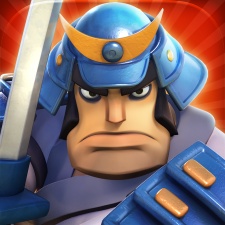As a journalist, so many 'rooms' these days seem to 'contain an elephant', the temptation becomes not to bother asking the question.
When it comes to UK developer Space Ape's mobile strategy game Samurai Siege, however, the metaphorical elephant effectively trumpets what everyone's thinking itself, as if to save everyone the trouble.
Yes, like hundreds of other mobile strategy games, Samurai Siege is inspired by Clash of Clans.
Also like Clash of Clans, Samurai Siege's success has come from standing on the shoulders of a number of previously successful games, combined with its own strand of innovation - as Space Ape's co-founder Simon Hade explains in this extensive Making Of article.
Pocket Gamer: Can you give us some background on Space Ape and how you formed?
Simon Hade: John [Earner] and I met at social gaming pioneer Playfish, as did many of the founding team. Some were there in the early days and worked on hit Facebook games such as Restaurant City, Pet Society and Sims Social while others came in after EA acquired the studio.
We believed the future was mobile and that the winners would be small tight teams of veteran developers so we left, raised some money from some of the top investors in gaming; people behind companies like Supercell, Gameloft and Rovio, and started Space Ape.
Along the way we joined up with Toby [Moore] who was the CTO at Mind Candy, makers of Moshi Monsters.
That was 18 months ago. Today we're 50 people, mostly based in Soho, central London, with employees in Tokyo and Beijing. Nearly 6 million people have played Samurai Siege and we're making $2 million a month.
Was Samurai Siege the game you were always going to make?
No! We spent the first 6 months making a sports game that you play while watching live NFL.
This was something really innovative and technically challenging because we're taking live data from the game, and presenting it to players in real-time to make a game around it. Every time there was a change in state in the game, the app would prompt you to predict what would happen next.
We decided we'd only work in the intersection of games we like to play and games people had shown they wanted to play.
The game did quite well so the decision to kill it was tough. We had over 40,000 players, thousands of 5-star reviews and interest from major broadcasters.
In hindsight it seems obvious that we'd be much more successful making games like Samurai Siege than sports games, but at the time it was not at all obvious since we'd spent over half of our funding and poured everything into that game.
What process was involved in coming up with the concept for Samurai Siege?
After the sports game we decided we'd only work in the intersection of games we like to play AND games that people had shown they wanted to play. The sports game met neither criteria so in retrospect was doomed to fail.
First we identified half a dozen genres that were performing well: games people had demonstrated they wanted to play. Then we ruled out a few. Card battle games for example. They were performing well but we couldn't relate to them. They were not games we liked to play.
Finally, we brainstormed ways that we thought we could improve on the best in each genre.

We rapidly prototyped different concepts in Unity until we were confident we'd found areas that we could move the genre forward. That process took about a month. In the end we settled on real-time strategy. We were all going home and playing Starcraft 2 at the time so that might have had something to do with it.
Obviously the game is inspired by Clash of Clans, so how did you balance the 'inspired by but not coping' issue?
Sure, we were inspired by Clash, just as Supercell was inspired by games like Backyard Monsters and Galaxy Life.
We started by committing to ourselves not to make the game unless we believed we could significantly improve on the best the genre had to offer. We talked to players live in the studio or over Skype every week and surveyed thousands of people to test our hypothesis.
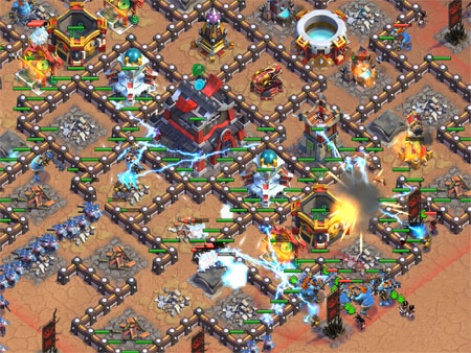
As soon as we had the most ghetto prototypes we'd put them in front of fans of the genre to test.
When we talked to players there was this recurring theme; they thought the clan gameplay was very shallow. Most people we talked to were lapsed World of Warcraft players so they were quite comfortable with harder core mechanics and community gameplay, they just didn't have time to play PC or console games any more.
It was obvious that we should add a war feature but also that there was an appetite for some of the other collaboration mechanics that Blizzard had perfected over the years.
Why samurais?
Who doesn't like samurais? We did a lot of testing of click-through rates and CPIs etc etc but ultimately it was a creative decision. This theme gave the art team a lot of scope.
The Mists of Pandaria World of Warcraft expansion had just come out too so that might have had something to do with it.
What do you consider the game's USPs within the mobile strategy genre?
Our single player experience is unique. In these games single player is usually an after-thought so we put a lot of time into balancing our content unlocks around this huge world that you progress through over several months.
We also brought in some staples of old school RTS games like freeze towers, AI influencing troops, collections etc. Also the artwork is amazing. But it was the alliance gameplay that really captured players' imaginations and so we went all in on that.
In Samurai Siege, alliances compete against three others in 12 hour events for premium currency. Alliance members need to work together to level up and unlock boosts and perks so players are really invested in their team. It's a big deal to let them down or leave and give up the alliance perks.
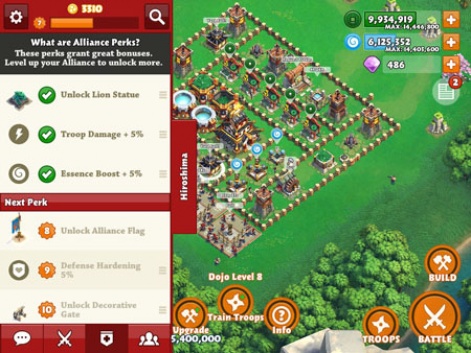
We added live events shortly after to give alliances even more to work towards. These are 48 hours events in the game when you can unlock limited edition content like special defences and premium currency. Having a well functioning alliance is critical to making the most of these events.
What's been your approach in terms encourage more casual players to get involved in alliances?
We put the social gameplay front-and-centre of the game. Samurai Siege is genuinely more fun with real people, so on the first day we introduce you to PvP via the single player missions, and not long after we introduce alliances. The translation of our name in Japanese is "Samurai Big War" so people know this is really what the game is all about.
The stats clearly show people who join an active alliance retain better than those who don't.
The operative word there is 'active'. If you join an inactive alliance then you're less likely to retain, so we have this recruitment feature where Shoguns of an alliance can advertise for new members. They might promote that they are a farming alliance, or that they go to war every day at a time that is convenient to people in western Europe or whatever.
The point is when a new player joins one of these alliances they receive a friendly reception and are less daunted by it.
You launched on iOS and Android. How important do you think that's been to your success?
Two years ago this was a really big deal. Now Unity just makes it so easy there is very little trade-off. Cross platform is table stakes and if you're smart about it you don't need to trade off anything in terms of performance.
Viral mechanics don't work for a mid-core audience.
We were live on both platforms on day one and it really helps with the word-of-mouth buzz. This is especially important for a multi-player game where liquidity is key. Our lives as developers sure would be easier if everyone used the same device - but it's just not the world we live in unfortunately.
What was the development process like? What tools did you use and how long, how many people were involved?
We started development of Samurai Siege in February 2013 with 12 people. We launched in Australia and New Zealand in July and tuned the game for a couple of months before going global in October. By then we were 18 people.
We used Unity for the front-end cross platform development and Scala and a lot of Amazon cloud services on the backend. We also use Ruby, Chef and Redis. The artists use Maya since a lot of our art is pre-rendered 3D. For analytics and A/B testing we use Swrve and our own Amazon Redshift data warehouse.
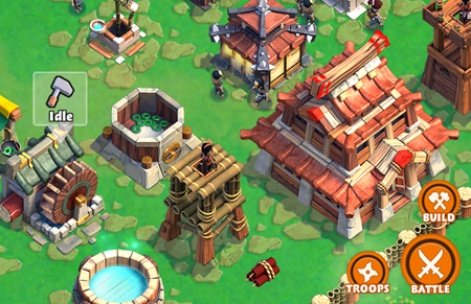
The development process was very agile. On such a tight timeframe it was the only way. The developers did a great job tooling up the game so we could really separate content and gameplay design from the core tech. Our designers could create defensive buildings, single player missions and tweak every troop stat and variable in the game, all the way down to the troop AI using a Google Spreadsheet and CMS.
That really helped to accelerate the development as it meant that development and design could happen in parallel, and these tools continue in the live game today.
Were there any particularly challenges you had to overcome during development?
The team had never worked in Unity or in Scala before so there was a learning curve. We also had no experience with 3D art pipelines since all our work at Playfish and Mind Candy had been in Flash. Not to mention when we started development we had one UI guy and no artists!
During the six months development we hired the entire art team, so making all that came together was very challenging.
We work very fast. That's our super power, and we got to 90 percent complete very quickly. However that last 10 percent of polish was tough. The bar for production values is high and getting higher on these platforms so ensuring that the UI is smooth and that the game looks slick was important.
How did you approach your soft launch period? Did this throw up any surprises?
We were profitable as a company during our beta in Australia! That was a big surprise.
Also, it turns out liquidity in a PvP game is super important. We hit a few times in beta when there was literally nobody to attack because all our Australian and New Zealand players were online or shielded. So we had to turn on Ireland. The Irish got their revenge during their day when the Aussies and Kiwis were asleep.
We were profitable as a company during our beta in Australia!
Another surprise was how engaged our community was. We'd been courting top players of this genre for six months to gather feedback, and when we launched in beta we had a big purple Give Feedback button on the main HUD.
I'd read and respond to every single email, then when it got too much we hired a full time community manager and a full customer support and community team. This was all pre-launch and it was great because not only did we get really useful feedback at scale, players literally saw suggestions they made one week, be implemented the next so we got this reputation for being a developer that really listens to the community.
The big surprise for me was how much of a driver this was for our business.
In most free-to-play games, businesses customer support is a bit of an afterthought at best. Today, customer support is a really big deal for us. A quarter of our headcount goes towards it, we have a dedicated VIP manager who constantly talks to top players, we host player nights at our studio and generally take it very seriously as it accounts for a big part of our business.
What's been your approach to monetisation? How did you design it into the game and have you been happy with the way it's been working?
We do not lock any content behind a pay wall. You can get access to everything in the game and participate competitively without spending any money. Key to this is that we allow players to farm premium currency through the Alliance Wars. If you are in an active warring alliance you can win premium currency every 12 hours.
Like most other games in the genre we monetize time. If you want to play for an extended period of time or do not want to wait for things to happen you can pay to speed things up. We also have an offerwall so players can complete thirdparty offers and watch videos in exchange for premium currency.
The game has been making $2 million a month since launch. We're pretty with the way it's been working.
UA seems to be the key issue for new developers launching a new game so as a relatively small, unknown developer, how did you approach getting users/installs? Do you still run active campaigns? What works well for you?
It's really tough. The platform is very competitive so you can have the best game in the world but if you don't have the capital to invest in marketing and the experience to optimise your UA, it's uphill.
To complicate things viral mechanics don't work for a mid-core audience. Our players will be very social in the game but are very reluctant to invite their real-life friends. It's very different from casual games where you can design effective viral mechanics.
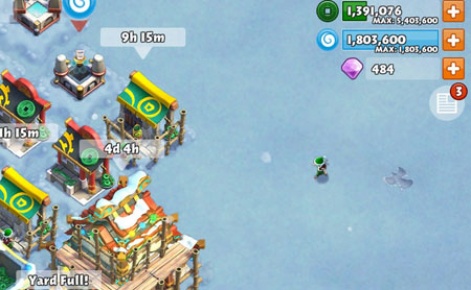
We invest a lot on UA. We have two full time acquisition people, an analyst and a data scientist who spend a lot of time on predictive modelling to figure out if we are paying too much or can afford to spend more. They use a combination of Ad-X, Swrve and our own data warehouse under Tableau.
We also make sure we're on the bleeding edge of anything Facebook does in this space because they have such a great mobile ad product but unfortunately it is a game of inches.
The platforms have supported us and do a great job of surfacing quality content. Discovery on the app stores is still key and I think at the end of the day good quality content does bubble to the top.
The mobile games market is now global, so what are the key territories for Samurai Siege? Have you actively worked to become successful in emerging territories or worked with specific partners to get into new markets?
We are live in nine languages, and 149 countries. Revenue is pretty evenly split between North America, western Europe and Asia. Japan is very important for us and accounts for 15 percent of revenue.
Japan is one of the biggest gaming markets, but very few western companies have any success there and no western company to my knowledge has rolled in successfully with a samurai theme! Japanese gamers have extremely high standards and authenticity is a big deal, so we spent a lot of time testing the game with players taking feedback.
Japan is very important for us and accounts for 15 percent of revenue.
We hired three native Japanese people (one in Tokyo, two in London), and spent months re-writing the script and preparing for launch. We were featured by Apple in a big way, got a lot of positive coverage from the gamer press and as a result got to No 3 in the download charts and top 50 in the grossing charts in our first two weeks.
This is something only a handful of western developers (all with much bigger resources at their disposal) have managed.
As for partners we get approached a lot by people wanting to publish our games, but so far it has made most sense to go it alone. No doubt we're giving up some reach but the economics work better for us and we're developing a competence in Asia that few game developers have.
We have 18 nationalities represented amongst our 50 employees so actually have pretty deep understanding of all our major markets.
Next on the list is Hong Kong, Taiwan, China and Korea, and we're still figuring out how best to approach them. Our theme and the live events work particularly well in Asia and we reach top 5 in many SE Asia markets with no localization nor local payment methods. I think there is a big opportunity to focus more on the region so we've just hired our GM of Asia based out of Beijing.
What's your approach to events?
Live events really differentiate Samurai Siege. This is something that is quite new for western mobile games.
In Samurai Siege, tournaments are 48 hour events that we do every 2-3 weeks. Currently we have three formats:
- Co-operative event where alliances work together to unlock limited edition items and premium currency over a 24 hour period;
- Competitive events where alliances war every three hours for a 48 hour period;
- A personal tournament where individuals are randomly assigned to rooms on day one qualifiers, and are then placed in Gold, Silver or Bronze rooms on day two depending on where they placed on day one.
Top prizes are generally within reach for the top 1-2 percent of players but lower level prizes are still within reach for casual players. There is also a global leaderboard for the ultra competitive players and winners have their names etched permanently in a hall of fame within the game.
We also run smaller scale events once or twice a week around changing some aspect of the economy (troop training time, loot hauls etc) as well as locally specific events; for example we have a promotion in Japan at the moment where the first 10 Japanese players to reach the top 100 globally receive approximate $2,500 worth of premium currency to divide amongst their alliance. The idea is that there is always something interesting happening in the game.
What's next for Samurai Siege and Space Ape?
Over half the company is committed full time to improving Samurai Siege and a growing part of the company is focused on a new game.
We've learnt a lot from Samurai Siege. That game was designed to be fast and our next game is designed to be the best. We're taking our time, using a lot of the things we learnt and keeping the practices that made Samurai Siege successful to putting that into the new game.
Key to this is hiring the right people to make sure they fit, but also being smart about listening to our players to ensure we're on the right track.
Thanks to Simon for his time.
You can check out Samuari Siege here. [iTunes link]

